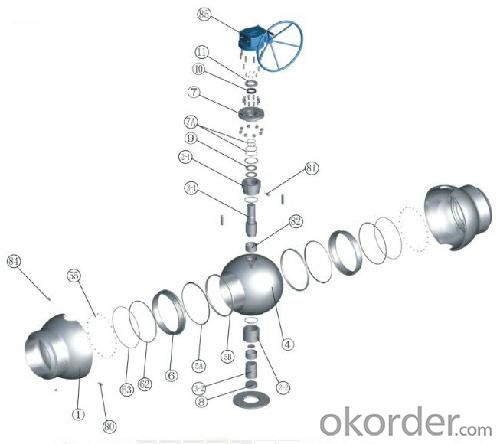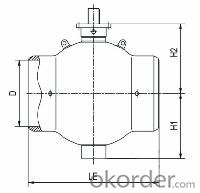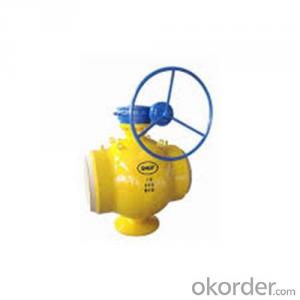full welded forged steel ball valve PN 10 Mpa
- Loading Port:
- Shanghai
- Payment Terms:
- TT OR LC
- Min Order Qty:
- 10 pc
- Supply Capability:
- 100 pc/month
OKorder Service Pledge
OKorder Financial Service
You Might Also Like
Design Features of full welded forged steel ball valve
The body of ball valve is full welded,selects high quality forged material,and adopts the advanced forged forming technology to form two semi-spheres which are welded into a whole in the middle of the body.This welding technology differentiates the ball valve form others,and makes the valve more spherically,so the valve structure is more compacter,lighter and stronger.Besides,the middle direct welding realize highly accurate valve body manufacturing,makes fully and completely sealing between the seat and ball.The full welding instead of bolts completely avoids the outside leakage,so ball valve is the ideal product for under-ground,offshore working platform and under-sea equipments.
Adopting fixed plates or trunnion to support the ball
The top and bottom of the ball is supported by upper and lower fixed plates or stem and trunnion,and the ball is accurately placed in the center of the ball valve to achieve complete seals and precise movements.When plate adopted,the force exerted by the medium to the ball is distributed via the plate to the left and right bodies,so that the stem does not bear the blending moment from the medium,but only the torque from the ball rotation during the opening/closing of the valve.The low-friction PTFE Teflon composite bearings installed between the ball axis and fixed plate and between the stem and the trunnion can absorb ball moving action caused by the pressure of the medium.This structure brings stable actions and easy operations for the ball valves,and the required operation torque can be reduced,so smaller actuators can be used,and the cost is cut down.
ball valve seat is floating structure,means the seat can move along the medium direction,so that the seat can fit against the ball all the time.
(Ⅰ)Double piston effect structure seat of full welded forged steel ball valve
Seat design is special double pistons effect structure,it can ensure the seal wherever the medium flows into the ball valve.


(Ⅱ)Seat multistage seal strucute of full welded forged steel ball valve
As following graphic instruction,on seat bearing ring,set two soft sealing rings(A and B)and metal sealing spherical surface which can seal with the ball.Seat ring A is spring loaded,which seals the surface with the ball tightly to the surface to form an initial seat;When there is pressure generated from medium,the piston force is generated to make seal ring A elastically deformed and seal ring B fit the surface of the ball surface due to the piston effect caused by area difference,thus the second seal forms.When the medium pressure is rising.It will generate huge pressure to seal ring A and seal ring B,so the two seals have a greater elastic deformation,then metal seal ball surface compact with ball surface to form the third level of metal to metal seal.

(Ⅲ)Secondary seat seal device of full welded forged steel ball valve
As the above graphic instruction,the secondary seal device(seat grease injection valve)can be chosen according to the actual working condition,medium requirement,seal requirement,etc.Seat ring grease injection valve is a one-way valve,installed on the body,which can prevent the leakage and inject grease under the outside force.When secondary seal is required,there is a grease injecting channel and hole on the seat ring.The grease can form a seal between the seat and the ball,and then stop the leakage.

Standards Applied of full welded forged steel ball valve:
Design Standard | API 6D customize |
Connection Standard | ASME B 16.25-2007 ASME B 16.5 ASME B 31.4 ASME B 31.8 DIN GB、GB/T JB、JB/T JIS customize |
Test Standard | API 6D customize |
Face to Face | API 6D customize |
Pressure-teperature rating | ASME B 16.34-2004 customize |
Marking | MSS SP-25 customize |
FAQ of full welded forged steel ball valve:
Q1:I can’t find the type of steel check valve which I need. what can I do?
The chart above only lists out some common composition of steel check valve parts.We may provide other different parts material composition according to the customer's request or the actual valve working condition.
Q2:Which certification do your products pass?
Our products are in accordance with ISO 9001、ISO 14001、API 6A、API 6D、TS CE、API607/6FA/BS6755.
Q3:How can I place an order?
The only one thing you should do is to tell us the sepecification about type 、quantity and mode of transportation, then we will send you quotation within 24 hours.
- Q: My sprinkler valve I just put in leaks from the top knobs you turn to allow water to pass through to the 3 main pvc pipes. I turn the water on on the main water line, open the little black twisty knobs to allow the water to pass through to the irrigation lines, but water leaks out through all 3 black twisty knobs. What do I need to do?!?!?!
- You are turning on electric valves, manually, with the bleeder valve (little black twisty thing). It is normal for this to happen. This valve can turn on and off a zone, but it also releases air from within the lines causing water to spit out with it. After the air is out, you can twist it down enough to stop the leak and still have that zone remain on.
- Q: What are the types of control valves used in the oil industry and how are they applied.
- There are other manual control valves and on/off automatic valves that are used a various places for remote or emergency control. These can be globe, gate, ball, plug or butterfly valves. They can be actuated by pneumatics, hydraulics or electric power.
- Q: my inflatable kayak has a self bailing drain valve. it says to close the valve in lakes and streams to stay completely dry and open it in oceans or mild whitewaters.whats the point of this valve? i WANT water to come in??
- Self Bailing Kayak
- Q: have a 86 flhtc had new cylinders 10-1 pistons supposed to be 86 cubic inches when i run it up to 90-95 bending valves what can i do to stop bending valves-------HARLEY DAVIDSON
- sounds like the high compression pistons dont have enuf valve relief( 2 little depressions on the top of the piston to keep the piston from smacking the valve). youll have to change brand of pistons, with more valve relief, or lower the compression ratio. next time before you completely put the heads back on, do so with out the head gasket and turn engine over by hand to see if the valves and pistons collide. (no head nuts either) if they collide, you will see the head rise up on contact. this could also be the lift and duration of the cam you are using. specifically the duration. if the valve stays open too long the piston will smack the valve that way too also at high revs, if the valve springs are weak, will cause the valve to float causing the piston to smack the valve
- Q: if i put a power valve on my honda xlr 125 would it make my bike have faster acceleration
- The powerband is caused by tuning an engine, they are most noticeable on a small lightweight 2-stroke. When you are riding and you change up too early you will have noticed the bike slows down and does not accelerate very well, but if you keep the rpms within a certain range it will accelerate smoothly – that is the effect of a powerband, it can be moved up or down the rev range by altering the ports and by changing the harmonics of the expansion chamber (the trumpet shape of the exhaust system). Either your garage is having a laugh at you or they are hopeless – I suspect the former. EDIT: You make it faster by tuning it –?making it less reliable and these bikes are already peaky. If you make them more peaky you will need to run them at higher revs –?higher revs = more power from available torque, therefore you do not want to move the powerband down the range or broaden it. Changing the sprockets will not improve acceleration AND top speed it is one or the other.
- Q: used in pipe line
- Bellows Relief Valve
- Q: what exactly is thc pcv valve and what does it do
- pcv POSITIVE CRANKCASE VENTILATION. this little valve serves as a means of scavenging the blow by gases that have made it passed the rings into the crank case. this valve replaced the earth draft tube on the earlier cars. it extends the life of the oil and improves fuel economy. at idle it is subjected to engine vacuum lifting the valve allowing air to flow through it. at higher speeds and on acceleration, vacuum drops closing this valve eliminating the flow of air into the cylinder from the block. in the event of a backfire, pressure builds up quickly in the hose that goes to this valve, slamming the valve shut eliminating the chance of an explosion inside the engine block.
- Q: Hello. I am interested in purchasing a Hydroclean Fill Valve for my toilet. Are these good fill valves? Thanks!
- who cares, a toilet fill valve only costs a few bucks. as long as it opens and closes it's a good valve. if it only lasts for a year then it's a piece of junk and you should try another brand. it's not a major decision
- Q: I have varicocele and varicose veins. Both conditions are caused by vein valves becoming damaged or defective. My question is, is this a sign of more serious problems?Thank You
- No it seems to be genetic. The valves just aren't doing thier job and allows some blood to flow backwards . They are unslightly.The place varicose veins is deadly serious is the back of your throat. They are caused by scaring of the liver generally by alcholism
- Q: What do I do to make my valves stop ticking? And what makes them tick? its a 94 Acura Integra with a 91 LS motor, 105,000 miles. If I get a new engine head will it stop ticking or the ticking has to do with the block?
- Just have the valves checked. They may be adjustable on that car. No, don't buy a head. It could be low oil pressure, blocked oil gallery, worn guides. Just get it checked out. At that mileage, I would not spend a lot of money on it. Just wait until you get a new car or get a whole engine rebuild. You may be able to drive it as is for another 100,000 miles.
Send your message to us
full welded forged steel ball valve PN 10 Mpa
- Loading Port:
- Shanghai
- Payment Terms:
- TT OR LC
- Min Order Qty:
- 10 pc
- Supply Capability:
- 100 pc/month
OKorder Service Pledge
OKorder Financial Service
Similar products
Hot products
Hot Searches
Related keywords




























